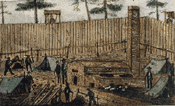 |
Confederate P.O.W. Camps |
|
State War Records |
| AL - AK - AZ - AR - CA - CO - CT - DE - FL - GA - HI - ID - IL - IN - IA - KS - KY - LA - MA - MD - ME - MI - MN - MS - MO - MT - NE - NV - NH - NJ - NM - NY - NC - ND - OH - OK - OR - PA - RI - SC - SD - TN - TX - UT - VT - VA - WA - WV - WI - WY |
Camp Groce Prisoner of War Camp
Search, View, Print Union & Confederate Civil War Prisoner of War Records, 1861-1865

Confederate 1863- 1864
Hempstead, Texas
By mid-1863, Texas Governor Francis R. Lubbock began to worry that the presence of Union prisoners being held at Huntsville, the Texas State Penintentiary, might attract an Union expedition to the area. Under his orders, a prison camp was established on some land offered to the state. The land belonged to Leonard W. Groce of the Liendo Plantation, 2.5 miles northeast of Hempstead. This site, one of the earliest cotton plantations in the state, had been used as a training center for Confederate troops when the war started.
The camp consisted of 4 stacks of barracks looking from 3 sides into a rhombus area. Beyond these barracks, a tract of wild country, woods, swampland, and a prairie stretched for miles around.
The camp sat at the top of a gentle 200 yard slope above the railroad grade. The distance included a thin line of timber and rough ground covered with scrubbrush. Off in the opposite direction, about 1/4 mile away, a small, sluggish brook ran through the property.
The first group of 132 Union prisoners were sent to the camp during the last week of June 1863. A group of about 100 prisoners was moved from the Texas State Penintentiary the first week of August.
The guard detachment consisted of 60 to 80 militiamen under the command of Capt. Buster. In late September, a company of conscripts who escorted the additional prisoners to the camp, took over the guard duties. They were placed under the command of the new camp commandant, Col. Bates. The next month, in November, Bates was replaced by Lt. Col. Barnes.
LIFE & CONDITIONS:
The prison barracks at the camp were apparently an improvement over the prison cells at the Texas State Penintentiary. The conditions were also an improvement compared to the prisons at Houston and Galveston, according to the new camp prisoners.The guard's barracks ran parallel to the prisoner's, 100 yards or more away. The guards were strict and energetic in their duties, but not too proficient. The camp water supply was provided by 2 deep wells a few hundred yards away from the prison barracks. Rations were provided in small quanities. The prisoners could supplement their rations with extra food purchased from the local farmers that were allowed in the camp.
During the hot summer months, the prisoners were allowed to bathe in the nearby brook. They were also allowed to go out and gather brush to make verandas on the outside of their barracks for shade to sit in. Both of these activities were always under heavy guard. During the cold winter months, the prisoners were allowed into the woods to gather fuel for their fires.
During the prisoner-exchange, most of the prison camps in Texas were all but forgotten.
Illness had quickly spread across the camp. The prevailing illness at the camp was typhus flux, a serious contagious disease transmitted through body lice, and accompanied by a high fever; cerebral disorders, such as a stupor, delerium, and/or intense headaches; the eruption of a dark, red rash over the entire body; and acute or chronic diarrhea.
The camp was often found to have several different types of snakes found in the compound, along with a myriad of flies and other insects.
Although these conditions, along with the summer heat, made the camp uncomfortable, the camp did not become intolerable until September. This is when another 271 prisoners arrived. This more than doubled the original camp population. Doubling up on the bunks became neccessary. The prisoners were allowed to build additional shacks around the camp because of the overcrowding. The following month, local black laborers were put to work building a stockade around the camp. More prisoners continued to come to the already overcrowded camp. By the end of the year, most of the prisoners were transferred out of the camp.
For the most part, the camp was no longer a prison camp by January 1864. It remained abandoned for some time but served as a Confederate Army seperation center at the end of the war. The prison buildings were later dismantled.
